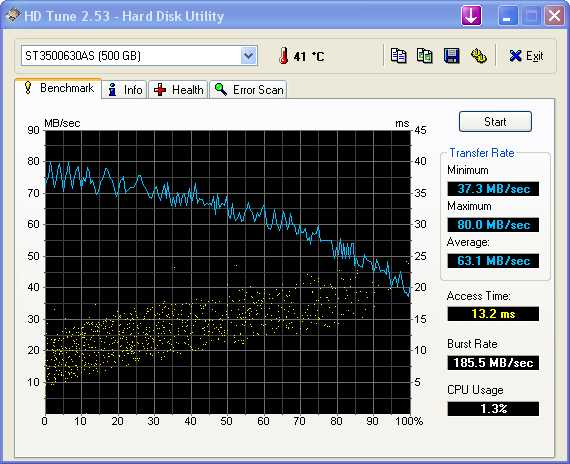Seagate 7200.10 500GB: Hitting the Sweet Spot
by Gary Key and Dave Robinet on July 6, 2007 11:00 PM EST- Posted in
- Storage
HD Tune / HD Tach

In previous HD Tune 2.53 testing the Raptor had the highest average read rate of 71.0 MB/s with the Hitachi 7K1000 at 69.4 MB/s while their T7K500 came in at 65.3 MB/s, Seagate 7200.10 500GB drive following fairly closely with 63.1 MB/s, Seagate's 750GB driver at 62.5 MB/s, Western Digital's YS 500GB drive at 62.4 MB/s, and falling way behind at 51.5 MB/s was the Seagate 7200.9 500GB drive. The 7200.10 has improved upon the 7200.9 series in this test by 22%.
In the HD Tach tests the sequential read speed at the 250GB level for the 500GB 7200.10, Hitachi 500GB, and WD 500GB averaged around 70 MB/s while the 7200.9 500GB was near 53 MB/s. The Seagate 7200.10 500GB, Hitachi 500GB and WD 500GB drives all score about 40 MB/s at the end of the disk. In contrast, the WD Raptor finished with a 52 MB/s result that is about 30% greater than the 7200 RPM drives.
It is important to note that access times, average read rates, and burst rate measurements are basically synthetic measurements, and while important these are not "true" application measurements. There is a great deal of potential bottlenecks elsewhere in the system that can and will affect the true performance of a drive. Although these "benchmarks" are a good indicator of a drive's performance, it is the total make-up of components in the PC that will determine the drive's actual performance.

 |
| Click to enlarge |
In previous HD Tune 2.53 testing the Raptor had the highest average read rate of 71.0 MB/s with the Hitachi 7K1000 at 69.4 MB/s while their T7K500 came in at 65.3 MB/s, Seagate 7200.10 500GB drive following fairly closely with 63.1 MB/s, Seagate's 750GB driver at 62.5 MB/s, Western Digital's YS 500GB drive at 62.4 MB/s, and falling way behind at 51.5 MB/s was the Seagate 7200.9 500GB drive. The 7200.10 has improved upon the 7200.9 series in this test by 22%.
In the HD Tach tests the sequential read speed at the 250GB level for the 500GB 7200.10, Hitachi 500GB, and WD 500GB averaged around 70 MB/s while the 7200.9 500GB was near 53 MB/s. The Seagate 7200.10 500GB, Hitachi 500GB and WD 500GB drives all score about 40 MB/s at the end of the disk. In contrast, the WD Raptor finished with a 52 MB/s result that is about 30% greater than the 7200 RPM drives.
It is important to note that access times, average read rates, and burst rate measurements are basically synthetic measurements, and while important these are not "true" application measurements. There is a great deal of potential bottlenecks elsewhere in the system that can and will affect the true performance of a drive. Although these "benchmarks" are a good indicator of a drive's performance, it is the total make-up of components in the PC that will determine the drive's actual performance.










19 Comments
View All Comments
VooDooAddict - Sunday, July 8, 2007 - link
Transfer performance differences of most drives seems negligible for single drive end users. Actual formated size, heat, warranty, noise, and the ever important price are the keys for end users.That isn't to say your performance numbers are useful. I'd almost bet that engineers from SAN manufactures like EqualLogic check out these reviews. When you have those performance differences amplified by running 14+ spindles it's a little more noticeable.
Kaleid - Sunday, July 8, 2007 - link
with platter density at record high 334GB.PenGun - Sunday, July 8, 2007 - link
You know some of us need to know how fast a drive writes. Any reason that information is not available? All these stupid unzip the file are just braindead.lopri - Saturday, July 7, 2007 - link
What is the theoretical advantage of 'perpendicular' design? Out of curiosity.TA152H - Sunday, July 8, 2007 - link
Better density.psychobriggsy - Saturday, July 7, 2007 - link
5 year warranty.'nuff said.
Although a 3 year warranty isn't so bad, but that last 10% of performance really doesn't excite me when it's regarding hard drives.
Yeah, yeah, I'm justifying my 320GB 7200.10 :p
JakeBlade - Saturday, July 7, 2007 - link
Sorry, that should be 1 out of 10. (Drank too much wine with my steak tonight).LoneWolf15 - Sunday, July 8, 2007 - link
Got any stats to back that up? If so, I'd love to see them. 10% within 10 months seems like an awfully high failure rate to me (unless you're talking about long-defunct brands like JTS and Kalok).JakeBlade - Saturday, July 7, 2007 - link
5 year, 10 year, 15 year warranty. When the drive is made dirt cheap from the disenfranchised workforce in China, any hard drive company can easily slap a warranty on anything that needs 1 out of every 25 replaced within 10 months, while still making a huge profit from cheap manufacturing costs. My source: Newegg -- 266 reviews, first ~25 from lowest rating report DOA/Failure.Golgatha - Monday, July 9, 2007 - link
sarcasmYes, I can't imagine that those who received a DOA hard drive or one that failed within a short period of time being a little miffed and taking their frustration out on the Newegg.com ratings boards.
/sarcasm